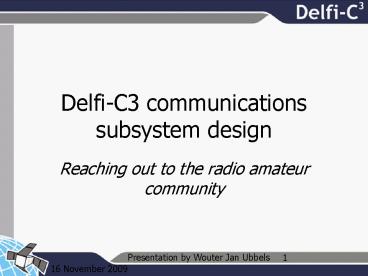DelfiC3 communications subsystem design - PowerPoint PPT Presentation
1 / 24
Title:
DelfiC3 communications subsystem design
Description:
Presentation by Wouter Jan Ubbels. 1. Delfi-C3 ... 1200 Baud AX.25 BPSK telemetry and telecommand. Low power 500mW 40KHz mode UV linear transponder ... – PowerPoint PPT presentation
Number of Views:201
Avg rating:3.0/5.0
Title: DelfiC3 communications subsystem design
1
Delfi-C3 communications subsystem design
- Reaching out to the radio amateur community
2
Who am I
- Wouter Jan Ubbels, MSc Student
- PE4WJ
- Delfi-C3 Communications
- W.J.Ubbels_at_delfic3.nl
- TU Delft, Aerospace Engineering
- Space Systems Engineering and Technology
3
Contents
- Delfi-C3 Mission
- Delfi-C3 Communications subsystem design
- Space segment
- Advanced transceiver
- AMSAT platform
- Frequency selection
- Antenna subsystem
- Ground segment
- Designing for space
- Conclusions
4
Delfi-C3 Mission
Delfi-C3 mission COMMS design Conclusion
- Educational objectives
- Hands-on engineering experience
- Teamwork and communication skills
- Motivate and challenge students
- Technical objectives
- In-orbit test of
- Thin Film Solar Cells
- Autonomous Wireless Sun Sensor
- Advanced Transceiver
5
Points of departure
Delfi-C3 mission COMMS design Conclusion
- Telemetry data budget requires about 800 bit/s
- Power budget 2-4 W available total array power
- No active attitude control ? tumble
- Use of amateur radio frequency bands, protocols
and modulation schemes - Distributed ground station network
- Advanced transceiver payload
- FCC / ITU uplink requirement
6
Frequency selection
Delfi-C3 mission COMMS design Conclusion
- 145.8-146 MHz (VHF) downlink
- 435-438 MHz (UHF) uplink
- VHF downlink, easy ? outreach
- No VHF uplink interference
- Compatible with AO-40 uplink equipment
- 3rd harmonic self-interference
7
Space segment
Delfi-C3 mission COMMS design Conclusion
- Advanced transceiver
- AMSAT platform
- 1200 Baud AX.25 BPSK telemetry and telecommand
- Low power 500mW 40KHz mode UV linear transponder
8
Advanced transceiver
Delfi-C3 mission COMMS design Conclusion
- Focus on high efficiency miniaturized linear PA
- Double loop negative feedback technique
- Prequalification for MISAT mission
9
AMSAT platform
Delfi-C3 mission COMMS design Conclusion
- Telecommand, telemetry and linear transponder
functionality - Proven concept
- Using standard off the shelf components
10
Antenna subsystem
Delfi-C3 mission COMMS design Conclusion
- VHF and UHF Quarter wave whips
- Matching network
- Near-omnidirectional pattern is desirable
- Phasing harness to provide circular polarization
- Deployment issues
11
Ground segment
Delfi-C3 mission COMMS design Conclusion
- Distributed ground station network
- Telemetry software will be made available to
participating amateurs - Data collection over the Internet
- Required equipment
- VHF / UHF SSB transceiver
- Tracking yagis
- TNC
- Telemetry software
- DELFI command ground station
12
Designing for space
Delfi-C3 mission COMMS design Conclusion
- Receiver dynamic range
- EMC ESD
- Radiation effects
- Structural loads
- Thermal vacuum
- Thorough testing
13
Conclusion
Delfi-C3 mission COMMS design Conclusion
- Dutch amateur radio operators are getting
involved - AMSAT platform Advanced transceiver PA design
has started - First CubeSat flying a linear transponder
- First Dutch OSCAR
14
Questions?
Delfi-C3 mission COMMS design Conclusion
15
RF frontend
16
MiSat
17
Delfi command groundstation
- Tracking VHF/UHF antenna system at 85m ASL
- Tracking S-band antenna system
- S-band to VHF downconverter
- ICOM IC-910 transceiver under computer control
- NOVA Tracking software
18
Interference canceling frontend
19
Quadrature oscillator
20
Advanced transceiver
- PA with integrated transformer
21
Advanced transceiver
22
Silicon-on-glass technology
23
Linear transponder concept
- Proven amateur satellite concept
- Combined with telemetry and telecommand
- Conflicting PA linearity requirement
- No eclipse operations (like AO-7)
- Ranging / Doppler tracking possible
- Nice test case for advanced transceiver
24
Designing for space
- Incorporate redundancy contingency options
- 2 uplink receivers on at all times
- ESD protection































